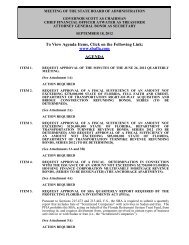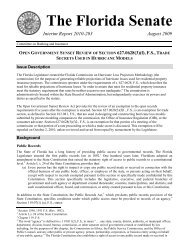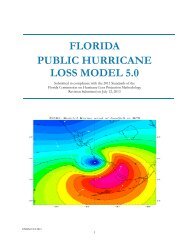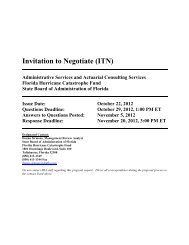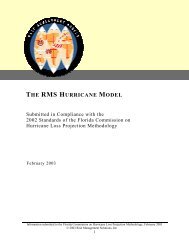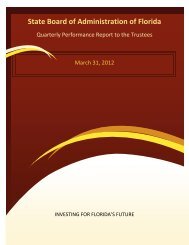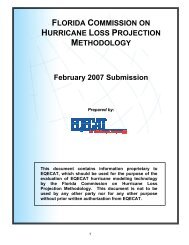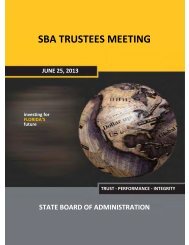EQECAT Model Submission - Florida State Board of Administration
EQECAT Model Submission - Florida State Board of Administration
EQECAT Model Submission - Florida State Board of Administration
Create successful ePaper yourself
Turn your PDF publications into a flip-book with our unique Google optimized e-Paper software.
The <strong>Florida</strong> Commission on Hurricane Loss Projection MethodologyGeneral Standardsthe insured loss components used in the model. The description shall be completeand shall not reference unpublished work.General description <strong>of</strong> Risk Quantification and Engineering TMRisk Quantification and Engineering TM (RQE) is <strong>EQECAT</strong>’s globalcatastrophe management s<strong>of</strong>tware, covering over 90 countries and the perils<strong>of</strong> hurricane / typhoon / cyclone (in <strong>Florida</strong> and elsewhere), windstorm,winterstorm, tornado, hail, wildfire, earthquake (ground shaking, fire following,sprinkler leakage, workers comp), and flood.The RQE platform is a networked, multi-user, client server architectureenabling enterprise-wide analysis using centralized and sharable databases.RQE uses a cost efficient industry standard computer infrastructure that caneasily expand to meet growing user demand. RQE uses standard PCs for enduser ‘clients’ running ordinary internet browsers. All users are networked tostandard Windows based servers which can be configured in scalableclusters to provide higher performance and capacity.RQE enables insurer and reinsurer analysis <strong>of</strong> multiple perils for over 90countries. A single product platform and user interface provides primary,facultative, treaty underwriting and accumulation management capabilityacross all lines <strong>of</strong> business with aggregation up to the corporate level. RQEalso provides underwriters with important information about risk volatility andthe impact <strong>of</strong> writing a new program on available capacity to enable real-timeportfolio optimization.One <strong>of</strong> the components <strong>of</strong> RQE is USWIND, a probabilistic model designed toestimate damage and insured losses due to the occurrence <strong>of</strong> hurricanesalong the 3100 miles <strong>of</strong> US coastline from Texas to Maine. Hereafter in thisdocument we use USWIND and <strong>Florida</strong> Hurricane <strong>Model</strong> 2013ainterchangeably. USWIND estimates the full probabilistic distribution <strong>of</strong>damage and loss for any scenario storm event. USWIND also calculatesAverage Annual Damage and Loss estimates, as well as annual probabilityexceedances using a database <strong>of</strong> 32,032 stochastic storm simulation resultsto develop average annual loss rates for each property site. Scenario andaverage annual damage and losses can be calculated for individual propertysites or for entire portfolios <strong>of</strong> residential and commercial properties.Scenario storms, derived from HURDAT, are used to estimate the mean andstandard deviation <strong>of</strong> damage and loss due to a single event. Any <strong>of</strong> the over100 years <strong>of</strong> historical storms contained in the storm database can beselected by users to calculate damage and loss. Damage and loss results forany <strong>of</strong> the 32,032 stochastic storm simulation results are also availablethrough the event loss table (ELT) reports.13



